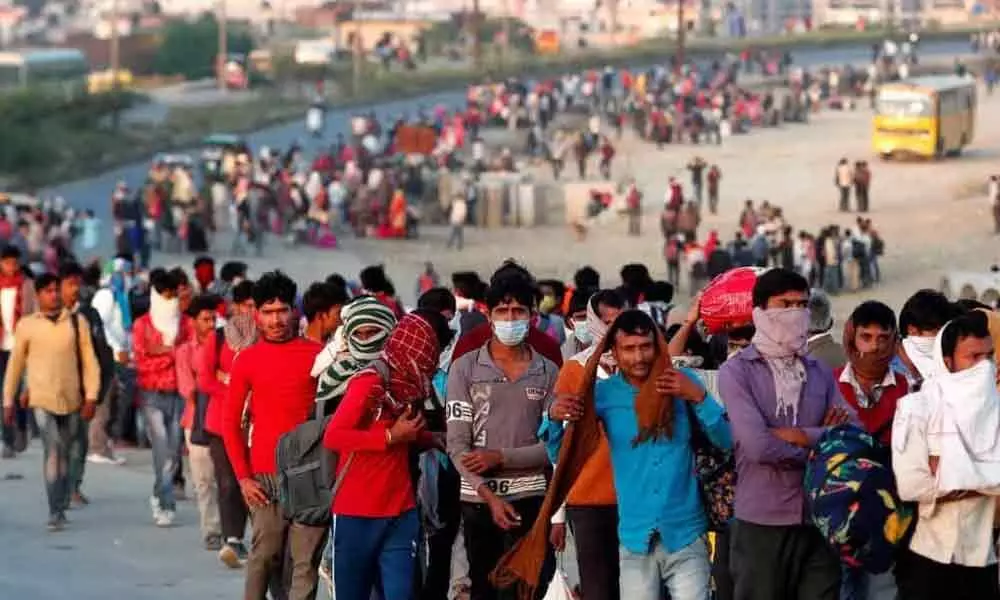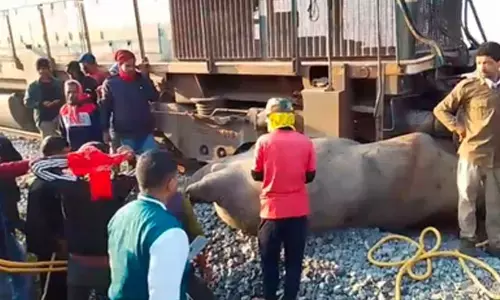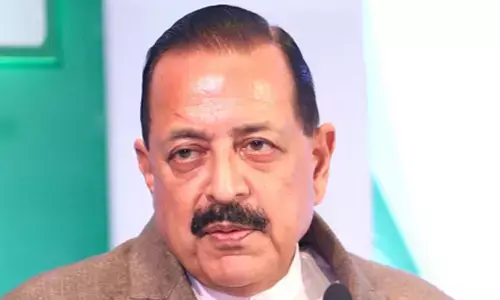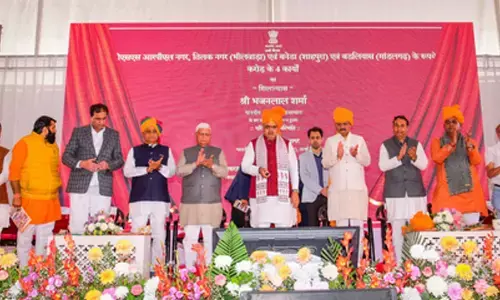Why are migrant workers so desperate?
 Migrant workers
Migrant workersUnlike international migration, the responsibility of internal migration would remain within a single country. There are instances of States in the federal structure of India cooperating as allies, not adversaries, while dealing with climate migration. In the present case of coronavirus lockdown, however, some States behaved like they were adversaries of each other and the migrant labourers rushing home were nobody's babies. Several States have sealed borders to stop urban-rural migration, without facilitating services that would have made their passage "safe, orderly and regular", thereby minimising the chances of spreading the infection, the very purpose of the lockdown in the first place
LockdownFrom the first week of the 21-day nationwide lockdown (now extended to May 3), one saw images of masses trying to return to their native villages in rural India with their bundled belongings by whatever means of transport they could lay their hands on — overcrowded train tops, bus tops, handcarts, bicycles — or literally laying their feet on the long path back home hundreds of kilometres away.
The scenes of outmigration from cities like Delhi were reminiscent of the Partition of India and the unprecedented population transfer that followed. The partition migration was triggered by a newly drawn line between two nations whereas the present exodus has highlighted another kind of divide within the country — between rural and the urban India.
There was one more remarkable difference — the sudden lockdown that led to the unanticipated displacement of migrant workers from cities like Delhi and its surrounding areas was meant for saving lives from coronavirus through maximising so-called "social distancing".
The search for a better life usually motivates a rural-to-urban migration. The question is whether the move has actually provided a life to these migrants any better than what they would have had in rural areas?
Now that we are witnessing the opposite trend, this gives us an opportunity to rethink internal migration in India and turn a grim situation into a less dire one, rather somewhat better eventually — both for rural folks and city-dwellers.
The Global Compact for Migration (GCM) agreed upon by most countries in December 2018 has aimed to make migration SOR — safe, orderly and regular. The Compact is meant to apply to international migration across borders, where the responsibility of implementation lies more with the destination countries.
However, can we not extrapolate it for internal migration as well? Could there be a pledge to make migration between rural India and the cities "safe, orderly and regular"? As for the lockdown migration, it was none of these, but there is scope to learn for the future. There can be a rethink followed by a planned strategy to make migration or displacement from urban to rural areas into one which is SOR.
Unlike international migration, the responsibility of internal migration would remain within a single country. There are instances of States in the federal structure of India cooperating as allies, not adversaries, while dealing with climate migration. In the present case of coronavirus lockdown, however, some States behaved like they were adversaries of each other and the migrant labourers rushing home were nobody's babies.
Several States have sealed borders to stop urban-rural migration, without facilitating services that would have made their passage "safe, orderly and regular", thereby minimising the chances of spreading the infection, the very purpose of the lockdown in the first place. What lessons could be drawn from this for the future well-being of India? One could be that the urban-rural migration can be incentivised by attracting people back or even to stay back in the rural areas, smaller towns if not villages, and decongest the cities and metropolises.
In India and elsewhere, wild animals are venturing on to urban streets, rivers are becoming cleaner, skies are turning bluer and urban air is becoming purer as a result of a temporarily absent human enterprise during the lockdown.
Even the incidences of urban ailments have come down, and it is believed that a large part of these were actually manufactured by the medical industry. Is there then a way to nurture and sustain such positive effects of the lockdown on the city environment in an effort to pre-empt a bigger disaster than the coronavirus?
There are pre-conditions and safeguards that need to be erected steadily if not speedily. It would not be an easy thing to do, but then, neither has been the lockdown.
If the people of India could live with the lockdown successfully, they should also be able to bear the cost of reimagining and rebuilding a different trajectory of rural-urban development in India. For example, it would help to curb rampant illegal construction activities in housing like those that go on throughout the year in colonies of the Delhi Development Authority where children, youth and the elderly are made to suffer from dust pollution, noise pollution and bad inter-personal relations among neighbours.
All this leads to low immunity against virus attacks and high incidences of urban ailments. On the other side, the rural folks are deprived of their youth sucked in by the cities — in their fastest growing sector of employment, which is construction. If people could be optimally distributed between the urban and rural areas then trade, commerce and services like education and health — and thereby construction too — could be incentivised to relocate there as the hubs in the so far deprived rural and semi-urban areas. The lockdown wave of migrant workers desperately returning home in their villages throws up a vital question. Why were they so desperate to move out? This is because they do not have the needed retention power to stay back in cities when a crisis strikes — neither physical nor mental.
Though the city offers higher wages and migrants earn more in urban areas, the higher income comes at the cost of their health, safety and well-being. Another question that comes to mind is: "Why has coronavirus been not reported to be as high in villages and rural India as in the cities? Is it because the rural folks have relatively better lungs, unspoilt by polluted air that their counterparts in urban India, both the rich and the poor, have been breathing?"
Perhaps the respiratory problems related to the weaker and more vulnerable lungs are specific creations of our cities, where clean air has become rare.
One unnoticed but major reason for this is the rampant unregulated / illegal construction activity that, fired by human greed, goes on unabated in the garb of renovations in otherwise complete structures in established housing colonies.
Previously, the Delhi government had aimed to reschedule the sweeping of its streets so that elders and senior citizens taking their morning walks were not exposed to the clouds of dust. It is not known what happened to that small but imaginative initiative; perhaps it was not insisted upon with the same grit that the present lockdown has been. It is never early to implement the lessons we have been forced to learn because of the coronavirus crisis. It has readied the people of India to accept drastic changes.
Fear of nature's fury has been greater than that of even the gods as the former has not yet been conquered by corruption whereas fake agents of the latter have ruled the roost! This, in my opinion, is the upside of the present downside.
(The author is a migration scholar and former professor, Jawaharlal Nehru University, New Delhi. Courtesy: Down To Earth)



















